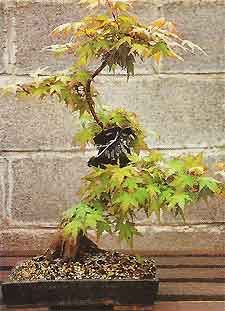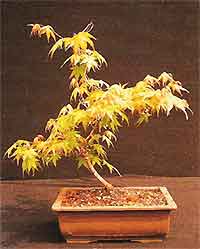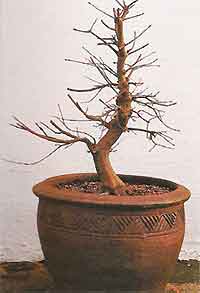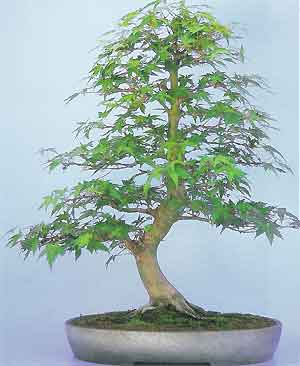Bonsai Trees
Case Histories
Japanese Mountain Maple - (acer palmatum)
Maple Bonsai Style: Informal Upright

In most bonsai collections there are trees that, for one reason or another, are never going to make good specimens unless drastic measures are taken. A friend from my local bonsai society had just such a maple amongst his many trees. One day in late spring when visiting him, he explained that he had grown the top of this bonsai far too quickly. He planned on removing it completely so that the tree could be restyled as a rather unusual semi-cascade, which he had decided would be a definite improvement.
The top of the tree had received over three years training and it seemed a shame to discard it. He had therefore just performed an air layering procedure to allow the top, when rooted, to be removed and become another bonsai maple. At the time I had no knowledge of this method of propagation and was most interested to hear what had been done.

To my surprise, he then offered me the actual air layer, when it had produced sufficient roots to survive on its own. I thanked him very much and was told that I could hopefully collect this new maple sometime during the next month.
Six weeks later my friend phoned to tell me that the air layer had been successful. Many roots had filled the bag and it was the ideal time to remove the top. I arrived soon after the call, together with a selection of deep bonsai pots that might be suitable for the maple. We severed the air layer and carefully unwrapped the polythene that enclosed the sphagnum moss and fresh new roots.

The tree was then potted into peat with the moss still in place, taking care not to disturb the delicate, brittle new roots. To assist the tree whilst establishing, the trunk was tied in the pot tightly so that it was secure and could therefore not move and damage the roots. I was delighted with my new tree. Although the roots were less than six weeks old, the tree itself was already almost four years old and looking quite presentable. The whole process had been amazingly easy and I looked forward to trying it out myself.
Maple Bonsai History: Training
As the maple began to grow strongly I started feeding and allowed it to grow freely for the rest of the year. When I repotted the next spring, the pot was full of healthy, fibrous roots and I removed all traces of the moss. The surface roots were incredibly well spaced and looked natural, emerging just above the original cut. This was going to be a real feature of this tree. It remained in the pot for the rest of the year, where it received some light pruning and general maintenance.

However, I was not enamoured with the sharp trunk curve. It still looked rather unnatural and artificial. The trunk was too thick to bend, but I was confident that if it was planted in the ground for a few years, it would thicken and the angle would become less pronounced and obvious. That spring the maple was planted in my front garden, where over the next five years it grew into a fairly large tree of over 1 1/2 metres in height (5 feet), despite some hard pruning.
After this time in the ground, the tree was planted in a large patio pot, where it was kept trimmed for a further three years until being planted back into a bonsai pot. The trunk was much thicker and as a result of pruning and regrowing a leader, tapered well. More importantly the strong curve was now less severe and appeared far more gentle. The surface roots were exposed and were quite breathtaking. I had forgotten just quite how convincing they were. The bonsai was now ready for some serious training and attention.
It would have been easy to persevere with the existing maple bonsai which could never have been improved to my satisfaction. Instead, by being bold and starting again, an exceptional maple has been created with excellent prospects for the future.
 In most bonsai collections there are trees that, for one reason or another, are never going to make good specimens unless drastic measures are taken. A friend from my local bonsai society had just such a maple amongst his many trees. One day in late spring when visiting him, he explained that he had grown the top of this bonsai far too quickly. He planned on removing it completely so that the tree could be restyled as a rather unusual semi-cascade, which he had decided would be a definite improvement.
In most bonsai collections there are trees that, for one reason or another, are never going to make good specimens unless drastic measures are taken. A friend from my local bonsai society had just such a maple amongst his many trees. One day in late spring when visiting him, he explained that he had grown the top of this bonsai far too quickly. He planned on removing it completely so that the tree could be restyled as a rather unusual semi-cascade, which he had decided would be a definite improvement. To my surprise, he then offered me the actual air layer, when it had produced sufficient roots to survive on its own. I thanked him very much and was told that I could hopefully collect this new maple sometime during the next month.
To my surprise, he then offered me the actual air layer, when it had produced sufficient roots to survive on its own. I thanked him very much and was told that I could hopefully collect this new maple sometime during the next month. The tree was then potted into peat with the moss still in place, taking care not to disturb the delicate, brittle new roots. To assist the tree whilst establishing, the trunk was tied in the pot tightly so that it was secure and could therefore not move and damage the roots. I was delighted with my new tree. Although the roots were less than six weeks old, the tree itself was already almost four years old and looking quite presentable. The whole process had been amazingly easy and I looked forward to trying it out myself.
The tree was then potted into peat with the moss still in place, taking care not to disturb the delicate, brittle new roots. To assist the tree whilst establishing, the trunk was tied in the pot tightly so that it was secure and could therefore not move and damage the roots. I was delighted with my new tree. Although the roots were less than six weeks old, the tree itself was already almost four years old and looking quite presentable. The whole process had been amazingly easy and I looked forward to trying it out myself. However, I was not enamoured with the sharp trunk curve. It still looked rather unnatural and artificial. The trunk was too thick to bend, but I was confident that if it was planted in the ground for a few years, it would thicken and the angle would become less pronounced and obvious. That spring the maple was planted in my front garden, where over the next five years it grew into a fairly large tree of over 1 1/2 metres in height (5 feet), despite some hard pruning.
However, I was not enamoured with the sharp trunk curve. It still looked rather unnatural and artificial. The trunk was too thick to bend, but I was confident that if it was planted in the ground for a few years, it would thicken and the angle would become less pronounced and obvious. That spring the maple was planted in my front garden, where over the next five years it grew into a fairly large tree of over 1 1/2 metres in height (5 feet), despite some hard pruning.